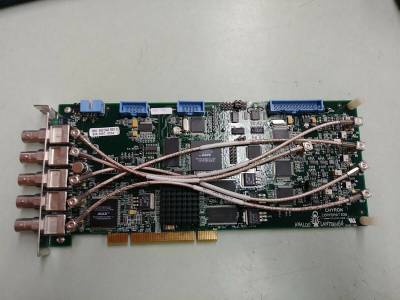Chyron Lantern (Digital PC CODI PCI)
I have a Chyron Lantern-64 Analog character generator card, which I picked up on ebay in early 2024. This card can accept PAL or NTSC video and key, and outputs the same. A separate genlock input is also present, which allows the same video input reference to be daisy-chained into several cards. Curiously it also has an analog audio output, LTC timecode input and 16-bit GPIO port.
As far as I can tell, this card (or at least my card) doesn't work directly with Chyron's Lyric or Lyric-Digiscribe software, but Lyric can be used to create and edit messages, fonts and graphics in iNFiNiT!/MAX/MAXINE format, which can then be loaded into the pcCODI API.
About the CODI series (and some disambiguation)
The CODI series is a range of video character generators from Chyron.
The “Blackbox CODI” was the original; it's a 19-inch black rack-mounting box with a serial port interface. The serial port is used to connect it to a host system, which sends drawing commands to the CODI. They are usually NTSC-only, and were widely used for EAS (Emergency Alert System) message display setups.
Chyron later released a PC ISA card called the “PC-CODI” (part number 6A11257). This was essentially a Blackbox CODI built onto an ISA card, and was controlled from MS-DOS similarly to the Blackbox.
After the ISA CODI, Chyron produced a PCI version, based around a Philips Trimedia processor. This is again called the “pcCODI” (unfortunately), but also carries the name “Lantern” – i.e. “Lantern 32” or “Lantern 64” for digital cards with SDI in/out and an analog preview port, or “Lantern 64 Analog” for the later card with composite video in/out.
The later PCI versions of the CODI series cards (branded Lantern or Digital PC-Codi) occasionally turn up on eBay. Generally these are the digital SDI in/out cards, but analog cards occasionally appear.
The three versions of the Lantern mainly differ by the amount of onboard RAM and the video input and output formats:
| Model name | Part number(s) | Artwork name | RAM | Video/audio I/O |
|---|---|---|---|---|
| Lantern-32 | 6A01336 | “Digital Lantern32” | 32MB | Digital (SDI) in/out, Toslink or SPDIF audio  |
| Lantern-64 | 6A01338 | “Digital Lantern64” | 64MB | Digital (SDI) in/out, Toslink or SPDIF audio  |
| Lantern-64A | 6A01343 6A91343 | “Analog Lantern64” | 64MB | Analog (composite) in/out, analog audio |
All the above cards run on the same TriMedia TM1300 processor, and use the same drivers (PC CODI SDK 3.10). They only work on Windows 98, 2000 and XP, 32-bit versions only. There are no 64-bit drivers that I'm aware of. That makes these cards usable, but they are a bit of a relic.
There's also a “Digital Codi Board” (6A01311, 6A01311T, 6A31311), which I can't find much information on other than ebay listings. I expect it's an early version of the Lantern-32, and has a 143MHz TriMedia TM1300 processor.
The good news is, because most of the video processing is done on the TriMedia card, they can be used with a fairly low-spec PC. Mine is installed in a 2.5GHz Intel Q8300 system, but that's just because the machine was lying around. The CODI would be equally at home in a 500MHz Celeron or Pentium III system, or perhaps a low-power Mini-ITX build with a PCI riser card.
Documentation
-
- While this manual doesn't cover the pcCODI directly (and the GPIO pinout is definitely wrong), it includes the LTC timecode port pinout.
Software
CODI SDK
I am trying to find other software to use with the CODI. It appears that it can load Chyron iNFINIT! messages and fonts, which would mean it may be able to load files created with the Lyric graphics software.
Lyric itself doesn't seem to be able to drive the CODI.
Lyric
I've tried a few versions of Lyric (5.0 Digiscribe, 5.24) but have been unable to get them working with the CODI card. They may not be truly supported.
The Duet Micro X appears to use the CODI/Lantern card, see this ebay listing (archived)
TBD
- Chyron CAL SDK
- Seems to be for Duet and Leitch cards, but the README suggests it supports the pcCODI too.
Third-party
-
- This now seems to be available from Converge Horizons Inc - according to the NY business register, they closed down in 2003.
Setup and installation
This is fairly straightforward as vintage hardware goes.
- Set up Windows XP 32bit, apply all relevant updates and install the required drivers.
- Install the Lantern card in the PC
- Install the CODI SDK (version 3.10)
- Open Device Manager, and select the “Multimedia device” which has no drivers. Update the driver from
C:\Program Files\Chyron\CODI Developer Package\drivers. - Run
pcCODIAppto test the hardware/- You will need to Boot the CODI card first, then text and graphics may be displayed.
There are several documents in C:\Program Files\Chyron\CODI Developer Package (in Word format) which explain the features of the card.
I/O headers
My card came without the I/O brackets, so I've had to make my own…
LTC timecode
The LTC Timecode connector appears to be a 9-pin crimp-on IDC D-sub connector, terminated in a 10-pin IDC socket. The pinout is in the Duet Hardware Reference Guide.
GPIO
The GPIO pinout is in the pcCODI manual. This seems to be a 25-pin female crimp-on IDC D-sub, terminated in a 26-pin IDC plug, going by the photo on B&H's website (archived).
It appears that Chyron released a 16-key keypad called “KwiKeys” (mentioned on B&H's website, (archived) ) which connected 16 buttons and LEDs to the GPIO port. It seems like the example GPIO setup in the pcCODI manual may be the KwiKeys.
Do not use the GPIO pinout in the Duet manual! They are not compatible, despite using the same connector.
Analog audio out
The Analog audio out pinout is TBD.
